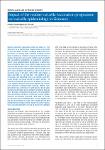Impact of the routine varicella vaccination programme on varicella epidemiology in Germany
Siedler, Anette
Arndt, U
Routine varicella vaccination with one dose for children of 11 to 14 months was recommended in Germany in 2004 to reduce disease incidence and severe complications. A country-wide varicella sentinel surveillance system was initiated in 2005 to detect trends of disease frequency and vaccine uptake and to evaluate the vaccination programme. A convenient sample of about 1,000 paediatricians and general practitioners was recruited to report on a monthly basis on varicella cases by age groups seen in their practice, and on varicella vaccine doses administered. Sentinel data from April 2005 to March 2009 show a reduction of 55% of varicella cases in all ages; 63% in the age group 0-4 years and 38% in 5-9 year-olds. The number of vaccine doses per reporting unit in all regions and physician groups increased during the same period. The number of reported cases as well as administered vaccines differed between physician groups and regions with different reimbursement policies. Where reimbursement was settled early and vaccine doses were increasing varicella cases started to decrease early as well. Besides reimbursement policies the availability and vaccination schedules influenced vaccine uptake. Sentinel surveillance provided valid data on trends for varicella associated morbidity, vaccine uptake and the age distribution of cases. The results confirm that following the introduction of routine varicella vaccination, varicella morbidity started to decline in Germany.
Dateien zu dieser Publikation
Keine Lizenzangabe

